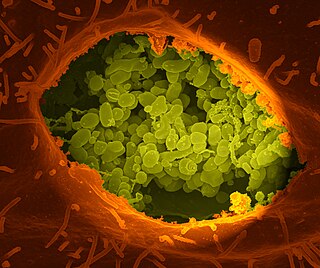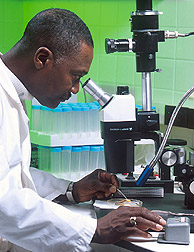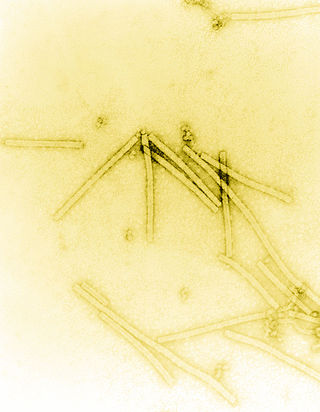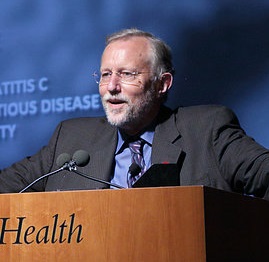Related Research Articles

Coxiella burnetii is an obligate intracellular bacterial pathogen, and is the causative agent of Q fever. The genus Coxiella is morphologically similar to Rickettsia, but with a variety of genetic and physiological differences. C. burnetii is a small Gram-negative, coccobacillary bacterium that is highly resistant to environmental stresses such as high temperature, osmotic pressure, and ultraviolet light. These characteristics are attributed to a small cell variant form of the organism that is part of a biphasic developmental cycle, including a more metabolically and replicatively active large cell variant form. It can survive standard disinfectants, and is resistant to many other environmental changes like those presented in the phagolysosome.

Robert Joseph Huebner, was an American physician and virologist whose research into viruses, their causes and treatment that led to his breakthrough insights into the connections between viruses and cancer, leading to new treatments, as well as his hypothesized oncogene, which was discovered to be a trigger for normal cells turning cancerous.

Herald Rea Cox (1907–1986) was an American bacteriologist. The bacterial family Coxiellaceae and the genus Coxiella, which include the organism that causes Q fever, are named after him.

Sir Michael George Parke Stoker CBE FRS FRSE MD FRCP was a British physician and medical researcher in virology.

Medical microbiology, the large subset of microbiology that is applied to medicine, is a branch of medical science concerned with the prevention, diagnosis and treatment of infectious diseases. In addition, this field of science studies various clinical applications of microbes for the improvement of health. There are four kinds of microorganisms that cause infectious disease: bacteria, fungi, parasites and viruses, and one type of infectious protein called prion.
The National Institute of Virology in Pune, India is an Indian virology research institute and part of the Indian Council of Medical Research (ICMR). It was previously known as 'Virus Research Centre' and was founded in collaboration with the Rockefeller Foundation. It has been designated as a WHO H5 reference laboratory for SE Asia region.

The history of virology – the scientific study of viruses and the infections they cause – began in the closing years of the 19th century. Although Louis Pasteur and Edward Jenner developed the first vaccines to protect against viral infections, they did not know that viruses existed. The first evidence of the existence of viruses came from experiments with filters that had pores small enough to retain bacteria. In 1892, Dmitri Ivanovsky used one of these filters to show that sap from a diseased tobacco plant remained infectious to healthy tobacco plants despite having been filtered. Martinus Beijerinck called the filtered, infectious substance a "virus" and this discovery is considered to be the beginning of virology.
Clarence James Peters, Jr is a physician, field virologist and former U.S. Army colonel. He is noted for his efforts in trying to stem epidemics of exotic infectious diseases such as the Ebola virus, Hanta virus and Rift Valley fever (RVF). He is an eminent authority on the virology, pathogenesis and epidemiology of hemorrhagic fever viruses.

Karl Maramorosch was an Austrian-born American virologist, entomologist, and plant pathologist. A centenarian and polyglot, he conducted research on viruses, mycoplasmas, rickettsiae, and other micro-organisms; and their transmission to plants through insect vectors in many parts of the world. He is the co-author of a textbook on techniques in virology and is the author of numerous papers on the biology and ecology of plant viruses, their hosts, and vectors. He received the Wolf Prize in Agriculture in 1980 for his contribution to the study of crop pathogens.
Hon. Richard Tedder FRCP is an English virologist and microbiologist, was head of the Department of Virology at the University College London Medical School, and worked as virologist at Public Health England
Ian David Gust AO, FRCPA, FRACP, MASM, FT is an Australian medical researcher, virologist, and former science administrator. Gust's area of work is in the development of drugs and vaccines against viral diseases and he is best known for the development of vaccines against the Hepatitis A virus. He currently serves as a non–executive company director and consultant.

David Maurice Surrey Dane, MRCS CRCP MB Bchir MRCP MRCPath FRCPath FRCP was a pre-eminent British pathologist and clinical virologist known for his pioneering work in infectious diseases including poliomyelitis and the early investigations into the efficacy of a number of vaccines. He is particularly remembered for his strategic foresight in the field of blood transfusion microbiology, particularly in relation to diseases that are spread through blood transfusion.

Charles Moen Rice is an American virologist and Nobel Prize laureate whose main area of research is the Hepatitis C virus. He is a professor of virology at the Rockefeller University in New York City and an adjunct professor at Cornell University and Washington University School of Medicine. At the time of the award he was a faculty at Rockefeller.
Guan Yi is a Chinese virologist. In 2014, he was ranked as 11th in the world by Thomson Reuters among global researchers in the field of microbiology. He obtained his PhD in microbiology at the University of Hong Kong and is now a professor of microbiology at his alma mater. His research on the viral respiratory disease SARS helped the Chinese government avert the 2004 outbreak of this disease. He is the current director of the State Key Laboratory for Emerging Infectious Diseases University of Hong Kong. In early 2017, Guan warned that the H7N9 influenza virus "poses the greatest threat to humanity than any other in the past 100 years".
Brian Ion Duerden is a British microbiologist.
Saumitra Das is an Indian microbiologist and a professor at the Department of Microbiology and Cell Biology of the Indian Institute of Science. Known for his studies in the fields of molecular virology and molecular biology, Das is an elected fellow of all the three major Indian science academies namely, the Indian Academy of Sciences, the National Academy of Sciences, India and the Indian National Science Academy. The Department of Biotechnology of the Government of India awarded him the National Bioscience Award for Career Development, one of the highest Indian science awards, for his contributions to biosciences in 2005.

Hélio Gelli Pereira was a Brazilian-British virologist specialising in adenoviruses. Pereira was a co-recipient of the 1988 UNESCO Carlos J. Finlay Prize for Microbiology and was known for his work on the book, Viruses of Vertebrates. He contributed to several areas of virology in research and international public service.
Xiang-Jin Meng, also known as X.J. Meng, is a Chinese-born American virologist. He is a university distinguished professor at Virginia Tech. He studies emerging, re-emerging and zoonotic viruses of veterinary and human public health significance. He was elected a member of the National Academy of Sciences in 2016, a Fellow of the National Academy of Inventors in 2014, and a Fellow of the American Academy of Microbiology in 2012.

Paul Fiset was a Canadian-American microbiologist and virologist. His research helped to develop one of the first successful Q fever vaccines, noted by The New York Times. Fiset was born in Quebec, Canada, and attended Laval University, where he earned a Doctor of Medicine degree in 1949. He subsequently attended Cambridge University, where he received a PhD degree in 1956. As a professor at the University of Maryland School of Medicine, he also researched other bacterial diseases such as typhus and Rocky Mountain spotted fever, in addition to Q fever.
Edwin Herman Lennette was an American physician, virologist, and pioneer of diagnostic virology.
References
- 1 2 3 4 5 6 7 Ayres, Jon (2014). "Barrie Patrick Marmion". The BMJ . 349: g5900. doi:10.1136/bmj.g5900. S2CID 72214401.
- 1 2 3 "Vale Professor Barrie Marmion". Monash University. 4 August 2014. Retrieved 13 November 2019.
- 1 2 3 4 5 "Barrie Patrick Marmion". Royal College of Physicians of Edinburgh. 19 May 2015. Retrieved 13 November 2019.
- ↑ Burrell, Chris (15 October 2014). "Barrie Marmion obituary". The Guardian . Retrieved 13 November 2019.
- ↑ Adams, Prue (19 August 2014). "Q Fever vaccine crusader Professor Barrie Marmion remembered as 'patient but persistent' microbiologist". ABC News . Retrieved 13 November 2019.
- ↑ Watts, Geoff (2015). "Barrie Patrick Marmion". The Lancet . 385 (9969): 684. doi:10.1016/S0140-6736(15)60278-1. PMID 25713861. S2CID 5407182.
- ↑ "Professor Barrie Patrick Marmion". honours.pmc.gov.au. Archived from the original on 13 November 2019. Retrieved 13 November 2019.